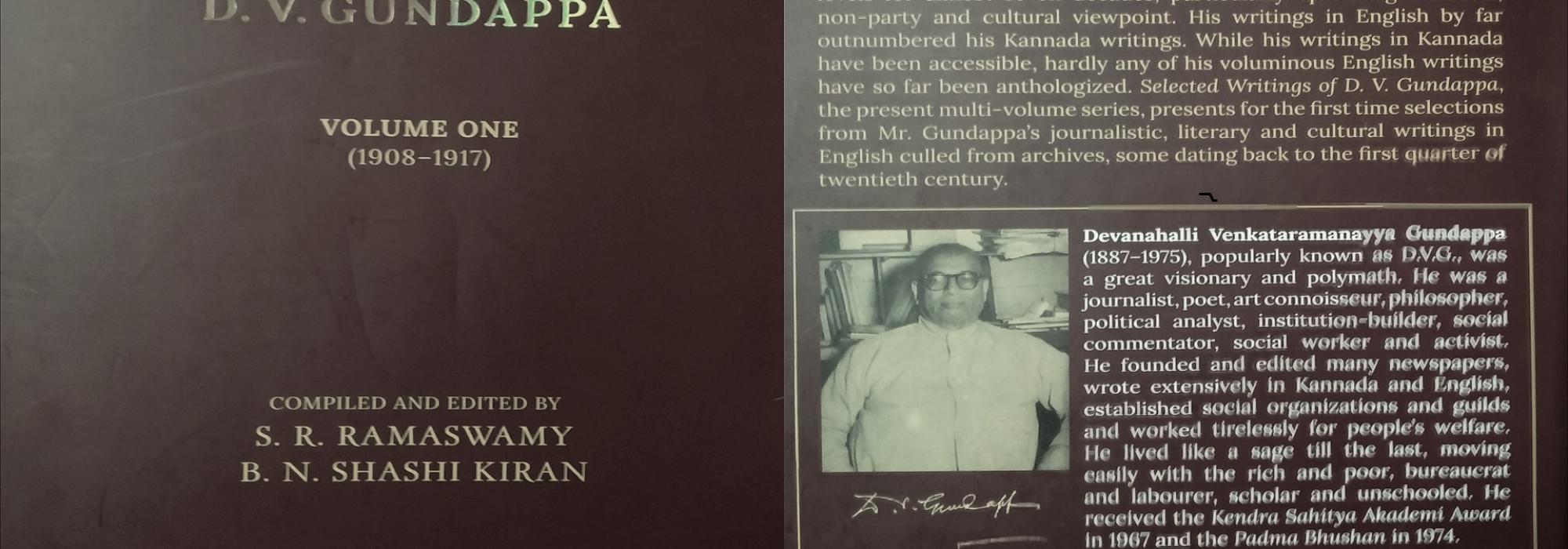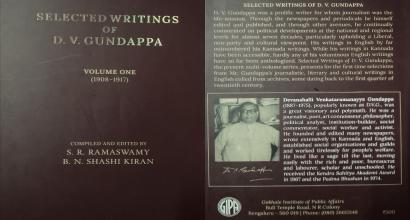Volume Seven (1957–1960)
DVG’s literary output in the 1950s—both in English and Kannada—was staggering. After retiring from active public life, he gave himself to literary pursuits and produced a remarkable variety of works – expository, analytical, appreciative, contemplative. The present volume includes all these kinds of writing and touches upon statecraft, music, literature and philosophy. Biographical memoir and exegetical commentary, genres for which DVG was well known, form the bulk of the book. Manu and Plato, Gokhale and Visvesvaraya – all appear in these pages, glowing with a new light.
In a talk broadcast over the All-India Radio in 1956, DVG has presented an overview of Plato’s Republic. He has explained the historical context of the treatise, highlighted its central tenets and brought out its significance to the modern world:
The Republic of Plato was the answer of a gifted mind to the challenge of a demoralized democracy. Athens, dear to Plato as the home of his fathers, had suffered a crushing defeat at the hands of better-disciplined Sparta. Public education in Athens had fallen into the hands of Sophists who, pretending to knowledge, promoted only delusion and confusion. As success in a democracy is for persons eloquent of tongue rather than sound in knowledge, and ingenious in argument rather than judicious and insightful in opinion, it was then the heyday of rhetoric and slogan in Athens. (pp. 6–7)
[… ] Plato is not a republican in the modern sense, nor a democrat. He is, if we may coin a new word, an elitocrat, an advocate of government by the wise and virtuous. (p. 12)
An important part of this talk is DVG’s exposition of justice vis-à-vis the Indian concept of dharma:
The definition of justice in the Republic is (i) that each man should perform only that function to which he is, by his nature, best fitted; (ii) that each should be able to get and keep and do what is his own; (iii) that he should do nothing which is not in consonance with three other virtues, namely — (a) wisdom or the understanding of the true nature of things in the case before him, (b) courage or the outspoken expression of his mind about things to be feared or to be welcomed, and (c) temperance or control over impulses and desires so as to subordinate the lower part of man’s nature to the higher. In modern idiom, justice is that kind of social order in which everyone is free to develop what he considers the best in him consistently with the similar freedom of everybody else and also conformably to the requirements of reason, public opinion and preference for the ethical over the appetitive … These are all ideas implicit in the Hindu concept of dharma. (pp. 18–19)
In an essay contributed to the Triveni journal, DVG has contemplated on the concept of dharma once again, this time in relation to Liberalism:
Self-fulfilment, justice, self-dissolution; liberty, law, universal fellowship: such are the three basic ideas of dharma, the code of ethics designed to sustain life and give it purpose and direction. It is a code of the true good, both of the individual and of his entire field of being. (p. 47) Dharma is thus the harmonizing and blending of two categories of the good: the individual’s and the community’s. It holds that neither kind of good is fully and truly achieved without the other’s being in that very process realized. (p. 48)
Liberalism is both a philosophy of politics and a technique of government. Its chief ingredients are the rational evaluation of the policies and activities of the government, the minimizing of governmental interference in the life of the people, the maximizing of the citizens’ voluntary contribution to general welfare, the mobilizing of private goodwill and good sense instead of the machinery of law and official authority to achieve social ends, frugality and prudence in the management of public money, vigilance over the performances of public functionaries, avoidance of partisanship and of fanaticism in the shaping of public policy, informing the intelligence and activizing the conscience of the community in all matters of moment to the public: these are the duties of the enlightened citizen in a democratic polity, and their aim is to secure and extend the field of freedom for the individual for his full and beneficent self-fulfilment, for the performance of his sva-dharma. (p. 72)
This essay, written in DVG’s seventy-first year, can be considered his definitive testament embodying his deeply held convictions. The philosophical underpinnings of Liberalism, an account of its development in England and India, its salient features – all these are elucidated here with a rare insight couched in stately prose. Although many scholars had written about Liberalism prior to DVG and have continued to write after him, it is perhaps DVG alone who has expounded on it from an Indian civilizational point of view.
Writing on Thomas Paine, DVG has masterfully summed up the rationalist’s contribution: “The whole life-work and writings of Thomas Paine are an illustration of the insufficiency of self-sufficiency in the pursuit after wisdom.” (pp. 84–85) DVG was not one to point out a flaw or a shortcoming and retire without explaining the reasons for it, without suggesting steps for course-correction. The following is illustrative: “Slapdash methods will not do in the handling of delicate issues, notwithstanding the plentifulness of goodwill.” (p. 85) “Politics is … applied ethics, and ethics is applied metaphysics. If democracy will not accept and keep true to these philosophical foundations of the good and the good life, its performances can be nothing better than the gropings of the purblind or the imitative exercises of the ape.” (p. 86)
This volume includes three essays on Sir M Visvesvaraya. Taken together with the longform in Kannada that appears in the fourth volume of DVG’s reminiscences (Jñāpaka-citra-śālè)[1], these essays are arguably the best material available on Sir MV the person. To give a brief historical background, it was Visvesvaraya who spotted DVG’s talent as a writer when the latter was in his twenties. He appreciated the young boy’s conscientiousness and steadfast commitment to the ethics of journalism and of life’s values in general. The relationship that began in early 1910s matured over the decades and continued uninterrupted till Visvesvaraya’s demise. Sir MV highly valued DVG’s opinions on public affairs, both when he was the Dewan of Mysore and later. The age-gap between the two was more than a quarter of a century, but this hardly came in the way of their mutual regard and collaboration. It would not be wrong to say that Visvesvaraya was a father-figure to DVG. Because of such close contact, DVG could write on Sir MV with an authority and insight that is rarely seen in the numerous works on the ‘modern tapasvī.’ DVG’s impeccable memory, his uncanny ability to capture subtle traits of personality through anecdotes, warm humanism, sound knowledge of politics and economics, and an overarching philosophical outlook have made his writings on Visvesvaraya unique and enduring. The article contributed to the Sir M Visvesvaraya Birth Centenary Volume in 1960 is a fine chronicle of an administrative period that deserves to be etched in gold in the history of Mysore. Let us sample a few paragraphs:
Conscience asks for correctness. In engagements as in dress, in social intercourse as in official business, the keyword to Sri Visvesvaraya’s manner is correctness. And it is a correctness which holds lack of grace and courtesy to be the opposite of what is correct. Anything smacking of rudeness or harshness grates upon that model of dignity and gentleness. He has known trials of temper and tribulation of soul as much as any son of man, though he scrupulously avoids such topics in conversation. But never did the gift of gentleness and dignity desert him even for once, whatever the degree of the provocation to be faced. (p. 98)
In one of his early speeches in Mysore he [Sri Visvesvaraya] said: ‘Put yourself under the guidance of a great purpose. That purpose will give shape and direction to your life. Life is good if it is used for a good purpose; and it is a good purpose to be of service to life around you in striving to supply what it needs. The best thing to do with life is to live and so to live as to enrich life for all.’ This surely is not materialism. Sri Visvesvaraya is no apostle of sensualism. His whole life is an example of purity and abstemiousness, of sense control and self-discipline. What to others are austerities are to him the beauties of soul. What to others is struggle and toll is to him worship and the felicity of bhakti. (p. 122)
[1] Translated into English as Art Gallery of Memories. Ref: The Dewans of Mysore (vol. 4). Bengaluru: Prekshaa Pratishtana, 2022. pp. 151–268
Nadoja S R Ramaswamy introduced me to the nuances of editing and provided incredible insights into the personality and works of D V Gundappa. Shatavadhani R Ganesh breathes life into all my activities. Sandeep Balakrishna patiently polished my prose and offered valuable suggestions to shore up the observations in this essay. I owe an immense debt of gratitude to all of them.
To be continued.








































